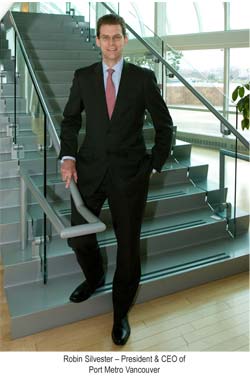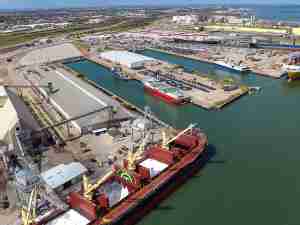 Robin Silvester, President & CEO of Port Metro Vancouver, told members of the Vancouver Board of Trade, December 4, 2009, that even though over the past year the port has been “operating in a fragile business climate and questioning past best practices … our industry and our economy will inevitably return to growth,”
Robin Silvester, President & CEO of Port Metro Vancouver, told members of the Vancouver Board of Trade, December 4, 2009, that even though over the past year the port has been “operating in a fragile business climate and questioning past best practices … our industry and our economy will inevitably return to growth,”
Overall, he said, declines at the port have slowed and some sectors have actually experienced positive growth recently - and he expressed optimism that this trend will continue.
“Our port grows in response to the needs of individuals and the economy,” he said, pointing to the fact that “in 1970 – about 40 years ago - the Port handled approximately 27 million metric tonnes of cargo at a time when the population of Canada was 21 million.
“This year, we estimate the Port will handle close to 100 million metric tonnes of cargo. The population of Canada is nearly 34 million. In 40 years, the population has increased by 60 percent, and the total cargo volume at the Port has nearly quadrupled.”
These increases, he said, indicate that population growth is a key driver for increased cargo volumes; both for demand-driven consumables on the import side and demand-driven commodities on the export side.
Silvester said: “We are a trading nation,” he said. “And, most importantly, we can be confident that a return to economic growth is inevitable.
“But, why just wait for an inevitable return to growth, when we can already start to plan and define a different and better future? We can change the way we think and act. If we move beyond just reactive response, our industry can lead a major change in thinking, and act to deliver a generational change — not only in key supply chain infrastructure, but in the way we understand and operate the entire supply chain, including impacts and benefits,” he said.
This change in thinking and planning, he said, must include the Pacific Gateway Initiative.
“By redefining our role we can inspire the confidence to believe in, and deliver, the full potential of the Asia Pacific Gateway as Canada’s most precious national asset.”Silvester said the Metro Vancouver portion of the Gateway has received more than C$4 billion in commitments from industry stakeholders and C$5 billion in commitments from the federal and provincial for Gateway projects such as:
- The Deltaport Third Berth will open in January and, along with its three new quad cranes, will increase cargo handling capacity at Deltaport by around 40%.
- Trade Corridor initiatives on the port’s North Shore and South Shore and from Roberts Bank, adjacent to the U.S. border, to Langley, B.C., to reduce traffic congestion for trucks.
- Private sector capacity buidling bulk terminal projects and Port Metro Vancouver’s proposed Terminal 2 project at Roberts Bank that will increase the port’s container terminal capacity by 2 million TEUs over the long term.
“In total, these projects comprise terminal development, road and rail grade separations, route extensions, and other landside enhancements that will smooth regional traffic flow, improve access to port facilities, and boost Gateway competitiveness,” Silvester said.
However, in a rapidly growing urban area such as Vancouver and surrounding cities such as Richmond, the availability of land for port development is key, he said. The availability, use, management, reclamation, leverage, of land is going to be the core of Gateway development going forward.
“We’re planning future supply chain requirements and considering how supply chains may change. We’re reviewing land availability and options, in earnest. We’re assessing physical constraints to growth – mountains, water, the border – finite land availability.”
He told Board members the port is aligning with community requirements, regional needs and g










